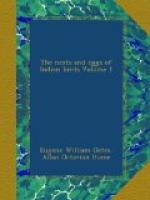Major C.T. Bingham writes:—
“This Crow, so common at Allahabad, is very scarce here at Delhi. In fact I have only seen one pair.
“At Allahabad it lays in February and March. I have, however, only found one nest, a rather loose structure of twigs and a few thick branches with rather a deep depression in the centre. It was placed on the very crown of a high toddy palm (Borassus flabelliformis) and was unlined save for a wad of human hair, on which the eggs, two in number, lay; these I found hard-set (on the 13th March); in colour they were a pale greenish blue, boldly blotched, spotted, and speckled with brown.”
Colonel Butler has furnished me with the following note on the breeding of the Jungle-Crow:—
“Belgaum, 12th March, 1880.—A nest containing four fresh eggs. It consisted of a loose structure of sticks lined with hair and leaves, and was placed at the top of and in the centre of a green-foliaged tree in a well-concealed situation about 30 feet from the ground. 18th March: Two nests, each containing three slightly incubated eggs; one of the nests was quite low down in the centre of an ‘arbor vitae’ about 12 feet from the ground. 31st March: Another nest containing four slightly incubated eggs. Some of the latter nests were very solidly built, and not so well Concealed. 11th April: Two more nests, containing five incubated and three slightly incubated eggs respectively; and on the 14th April a nest containing four slightly incubated eggs. These birds, when the eggs are at all incubated, often sit very close, especially if the nest is in an open situation, and in many instances I have thrown several stones at the nest, and made as much row as I could below without driving the old bird off, and I have seen my nest-seeker within a few yards of the nest after climbing the tree before the old bird flew off. On the 26th of April I found two more nests, one containing four young birds just hatched, the other three fresh eggs. On the 27th another nest containing three fresh eggs, and on the 28th a nest of three fresh eggs. On the 5th May two more nests containing four fresh and four incubated eggs respectively.”
“In the Nilghiris,” writes Mr. Davison, “the Corby builds a coarse nest of twigs, lined with cocoanut-fibre or dry grass high up in some densely-foliaged tree. The eggs are usually four, often five, in number. The birds lay in April and May.”
Miss Cockburn again says:—“They build like all Crows on large trees merely by laying a few sticks together on some strong branch, generally very high up in the tree. I do not remember ever seeing more than one nest on a tree at a time, so that they differ very much from the Rook in that respect. They lay four eggs of a bluish green, with dusky blotches and spots, and nothing can exceed the care and attention they bestow on their young. Even when the latter are able to leave their nests and take long flights, the parent birds will accompany them as if to prevent their getting into mischief. The nests are found in April and May.”




